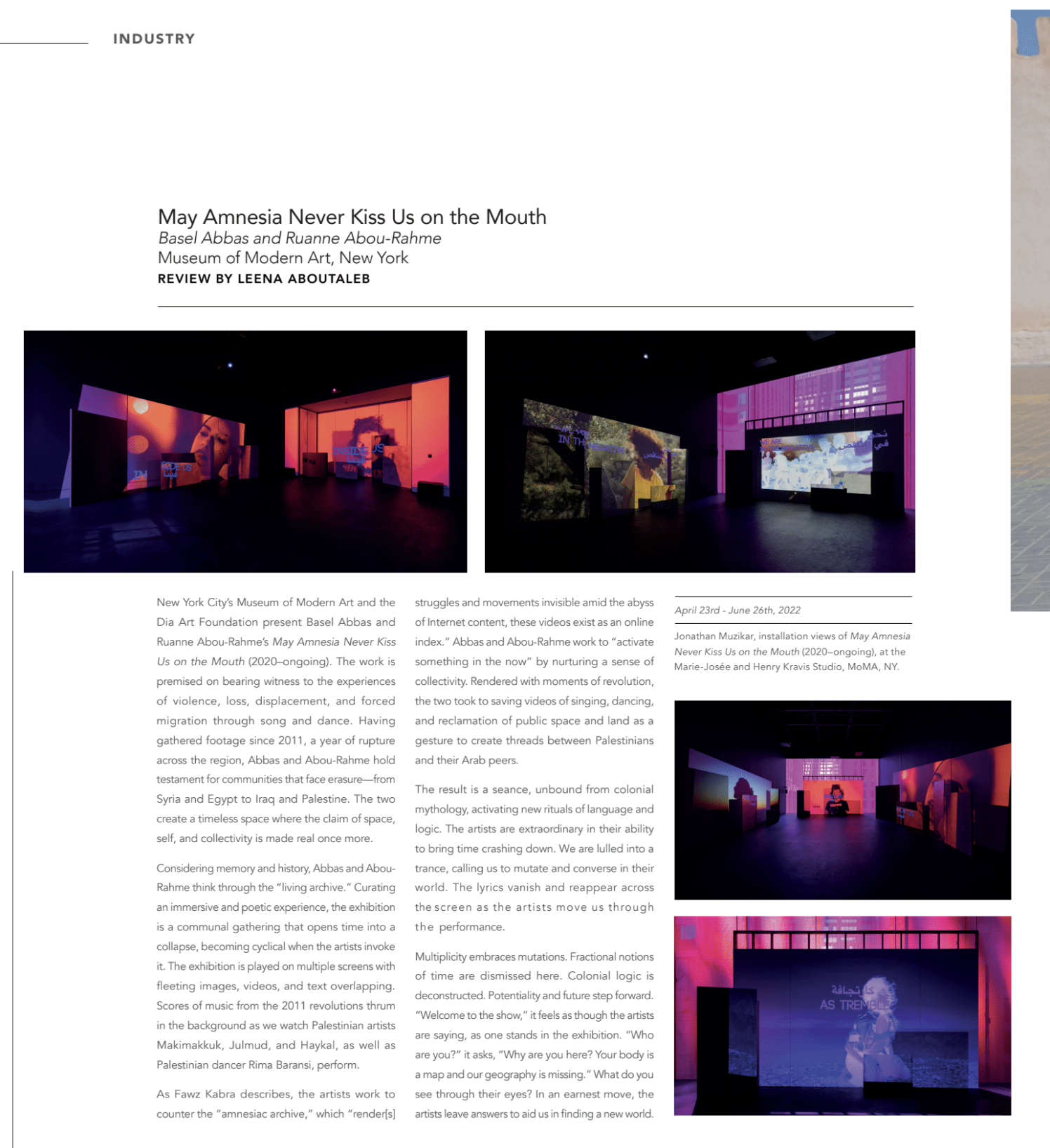Vanishing Time: Basel Abbas and Ruanne Abou-Rahme’s May Amnesia Never Kiss Us on the Mouth
by Leena Aboutaleb
New York City’s Museum of Modern Art and the Dia Art Foundation present Basel Abbas and Ruanne Abou-Rahme’s May Amnesia Never Kiss Us on the Mouth (2020–ongoing). The work is premised on bearing witness to the experiences of violence, loss, displacement, and forced migration through song and dance. Having gathered footage since 2011, a year of rupture across the region, Abbas and Abou-Rahme hold testament for communities who face erasure—from Syria and Egypt to Iraq and Palestine. The two create a timeless space where the claim of space, self, and collectivity is made real once more.
Considering memory and history, Abbas and Abou-Rahme think through the “living archive.” Curating an immersive and poetic experience, the exhibition is a communal gathering that opens time into a collapse: time becomes cyclical when the artists invoke it. The exhibition is played on multiple screens with fleeting images, videos, and text overlapping. Scores of music from the 2011 revolutions thrum in the background, as we watch Palestinian artists Makimakkuk, Julmud, and Haykal, as well as Palestinian dancer Rima Baransi, perform in the videos.
As Fawz Kabra describes, the artists work to counter the “amnesiac archive,” which “render[s] struggles and movements invisible amid the abyss of Internet content, these videos exist as an online index.” Abbas and Abou-Rahme work to “activate something in the now” by nurturing a sense of collectivity. Rendered with moments of revolution, the two took to saving videos of singing, dancing, and reclamation of public space and land as a gesture to create threads between Palestinians and their Arab peers.
The result is a seance, unbound from colonial mythology, activating new rituals of language and logic. The artists are extraordinary in their ability to bring time crashing down, lulling the viewer into a trance alongside them, giving us the chance to be in conversation with the artists and to mutate with them. The lyrics vanish and reappear across the screen as the artists move us through the performance.
Multiplicity embraces mutations. Fractional notions of time are dismissed here. Colonial logic is deconstructed. Potentiality and future step forward. “Welcome to the show,” it feels as though the artists are saying, as one stands in the exhibition. “Who are you?” it asks, “Why are you here? Your body is a map and our geography is missing.” What do you see through their eyes? In an earnest move, the artists leave answers to aid us in finding a new world.
Originally published in Tribe Photo Magazine, issue 13
Considering memory and history, Abbas and Abou-Rahme think through the “living archive.” Curating an immersive and poetic experience, the exhibition is a communal gathering that opens time into a collapse: time becomes cyclical when the artists invoke it. The exhibition is played on multiple screens with fleeting images, videos, and text overlapping. Scores of music from the 2011 revolutions thrum in the background, as we watch Palestinian artists Makimakkuk, Julmud, and Haykal, as well as Palestinian dancer Rima Baransi, perform in the videos.
As Fawz Kabra describes, the artists work to counter the “amnesiac archive,” which “render[s] struggles and movements invisible amid the abyss of Internet content, these videos exist as an online index.” Abbas and Abou-Rahme work to “activate something in the now” by nurturing a sense of collectivity. Rendered with moments of revolution, the two took to saving videos of singing, dancing, and reclamation of public space and land as a gesture to create threads between Palestinians and their Arab peers.
The result is a seance, unbound from colonial mythology, activating new rituals of language and logic. The artists are extraordinary in their ability to bring time crashing down, lulling the viewer into a trance alongside them, giving us the chance to be in conversation with the artists and to mutate with them. The lyrics vanish and reappear across the screen as the artists move us through the performance.
Multiplicity embraces mutations. Fractional notions of time are dismissed here. Colonial logic is deconstructed. Potentiality and future step forward. “Welcome to the show,” it feels as though the artists are saying, as one stands in the exhibition. “Who are you?” it asks, “Why are you here? Your body is a map and our geography is missing.” What do you see through their eyes? In an earnest move, the artists leave answers to aid us in finding a new world.
Originally published in Tribe Photo Magazine, issue 13
